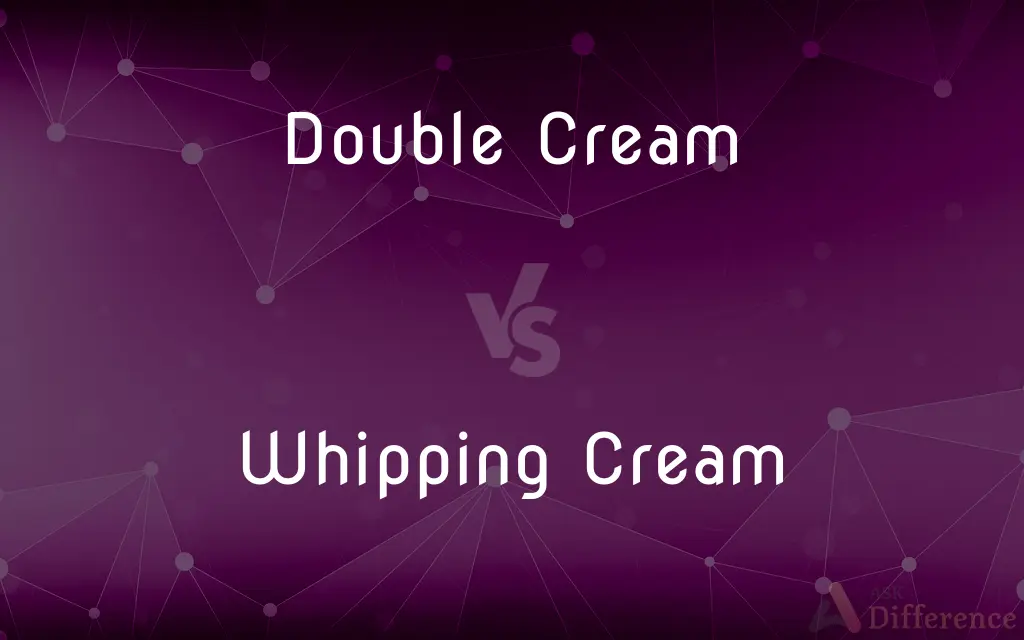Double Cream vs. Whipping Cream — What's the Difference?
By Tayyaba Rehman — Published on October 19, 2023
Double cream contains around 48% fat and is very thick, while whipping cream has about 35% fat and is lighter, making it suitable for whipping.

Difference Between Double Cream and Whipping Cream
Table of Contents
ADVERTISEMENT
Key Differences
Double cream, as its name suggests, is a rich and creamy dairy product with a high-fat content. On the other hand, whipping cream is lighter with a moderate fat content, making it ideal for aerating into whipped cream. Both these creams are used in various culinary applications, but their textures and fat percentages make them suitable for different purposes.
Double cream's richness and thickness arise from its elevated fat content, typically around 48%. Due to this high-fat percentage, double cream doesn't whip well but is excellent for recipes that require a dense, creamy consistency. Whipping cream, in contrast, contains about 35% fat, striking a balance that enables it to be whipped into soft peaks, yet maintaining a creamy texture.
In cooking and baking, the distinction between double cream and whipping cream is crucial. Double cream can be used to add richness to dishes like soups, sauces, or desserts without the risk of curdling. Whipping cream, given its capability to incorporate air, is often whipped with sugar to create whipped cream for desserts or as a topping.
Furthermore, while both double cream and whipping cream can be used in coffee, desserts, and various dishes, the final texture and richness will differ based on which one you choose. The high-fat content in double cream imparts a luxurious mouthfeel, while whipping cream offers a lighter, fluffier touch to dishes.
Comparison Chart
Fat Content
Around 48% fat.
About 35% fat.
ADVERTISEMENT
Texture
Very thick and rich.
Lighter and suitable for whipping.
Best Used For
Adding richness to dishes; doesn't whip well.
Whipping into soft peaks for desserts and toppings.
Curdling Risk
Lower due to high-fat content.
Higher compared to double cream.
Culinary Applications
Soups, sauces, dense desserts.
Whipped cream, lighter desserts, toppings.
Compare with Definitions
Double Cream
Contains around 48% fat.
Double cream's high fat percentage sets it apart from other creams.
Whipping Cream
Often sweetened and whipped for desserts.
She topped the pie with sweetened whipping cream.
Double Cream
Known for its dense and creamy consistency.
I prefer double cream in my coffee for a luxurious texture.
Whipping Cream
Can be aerated to create whipped cream.
Using a mixer, she turned the whipping cream into soft peaks.
Double Cream
Double cream is a dairy product with a high-fat content.
The recipe calls for adding double cream for extra richness.
Whipping Cream
Lighter in texture compared to double cream.
For a less dense sauce, I'd suggest using whipping cream.
Double Cream
Often used in cooking to add depth to dishes.
The soup was made velvety with a splash of double cream.
Whipping Cream
Whipping cream is a dairy product designed for whipping.
I bought whipping cream to make a dessert topping.
Double Cream
Doesn't whip well due to its elevated fat content.
Avoid trying to whip double cream; it's too thick for that.
Whipping Cream
Contains moderate fat, typically around 35%.
Whipping cream strikes a balance with its 35% fat content.
Common Curiosities
How does whipping cream differ from double cream?
Whipping cream is lighter with about 35% fat, making it ideal for whipping into soft peaks.
Is whipping cream suitable for sauces?
Yes, whipping cream can be used in sauces, providing a lighter texture compared to double cream.
What is double cream?
Double cream is a thick dairy product with a high-fat content, around 48%, often used to add richness to dishes.
Why does double cream have a thicker consistency?
Double cream's thickness is due to its elevated fat content, typically around 48%.
Will double cream curdle when heated?
Double cream's high fat content reduces the risk of curdling, making it stable when heated.
Can I whip double cream?
Due to its high-fat content, double cream doesn't whip well and may become too dense.
Are there any other creams besides double and whipping cream?
Yes, there are other creams like single cream, clotted cream, and heavy cream, each with different fat contents and uses.
Is double cream good for ganache?
Yes, double cream's richness makes it excellent for creating smooth and velvety ganache.
Which is richer in flavor, double cream or whipping cream?
Double cream is richer in flavor due to its higher fat content.
Can I substitute double cream for whipping cream in recipes?
While they can be substituted, the texture and richness will differ; double cream is denser while whipping cream is lighter.
Why does whipping cream aerate well?
Whipping cream's fat content (around 35%) is balanced to allow incorporation of air, making it whip well.
Which cream is best for making whipped cream for desserts?
Whipping cream is specifically designed to be whipped into soft peaks, making it ideal for desserts.
Are these creams natural?
Both double and whipping cream are natural dairy products, though additives might be present depending on the brand.
Can I use whipping cream in coffee?
Yes, whipping cream can be used in coffee, offering a creamy yet lighter texture than double cream.
Can I make butter from whipping cream?
Yes, by agitating whipping cream, you can separate the fat and make butter.
Share Your Discovery

Previous Comparison
MPEG vs. MPG
Next Comparison
Dark Ages vs. Medieval AgesAuthor Spotlight
Written by
Tayyaba RehmanTayyaba Rehman is a distinguished writer, currently serving as a primary contributor to askdifference.com. As a researcher in semantics and etymology, Tayyaba's passion for the complexity of languages and their distinctions has found a perfect home on the platform. Tayyaba delves into the intricacies of language, distinguishing between commonly confused words and phrases, thereby providing clarity for readers worldwide.
















































